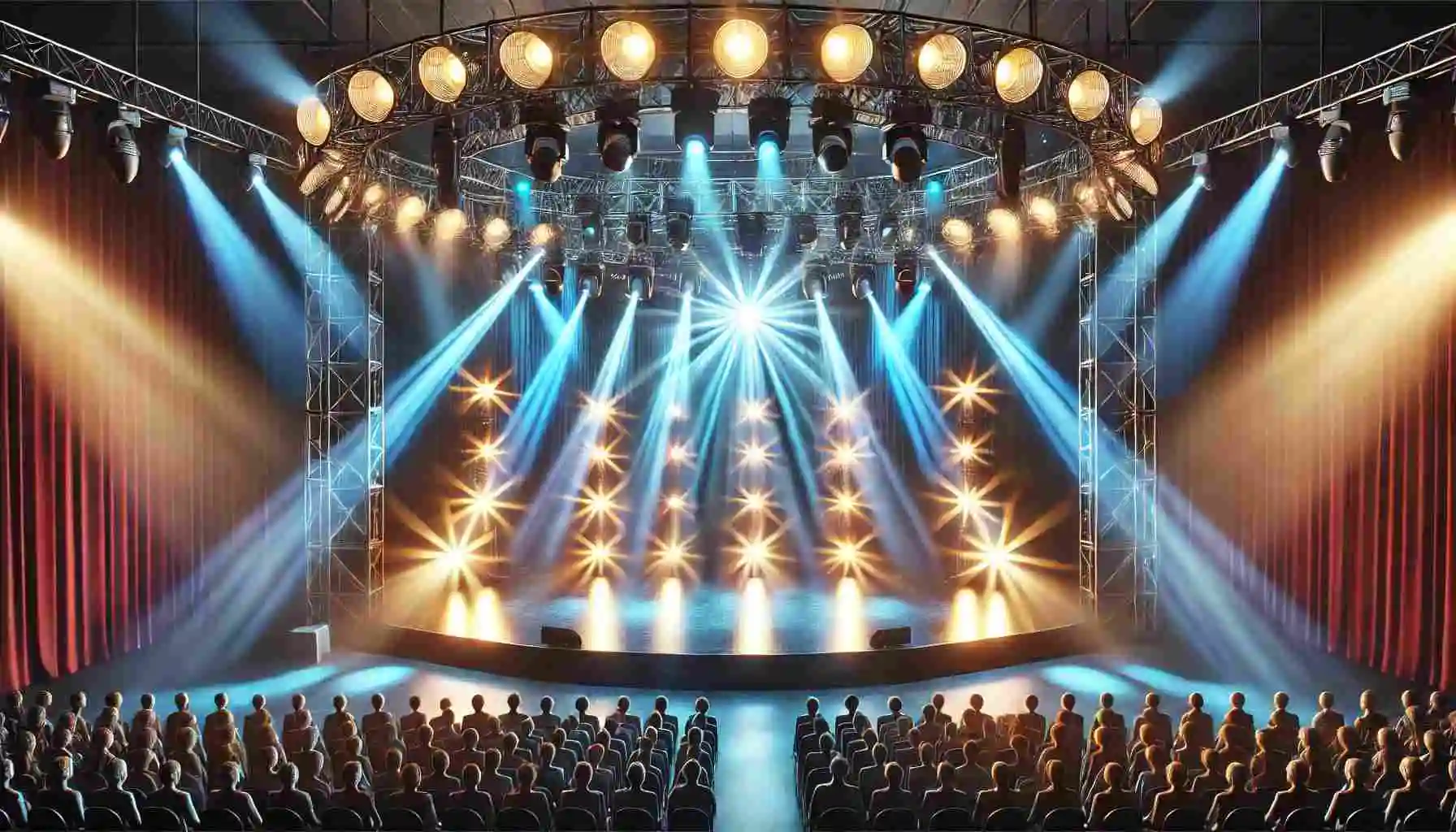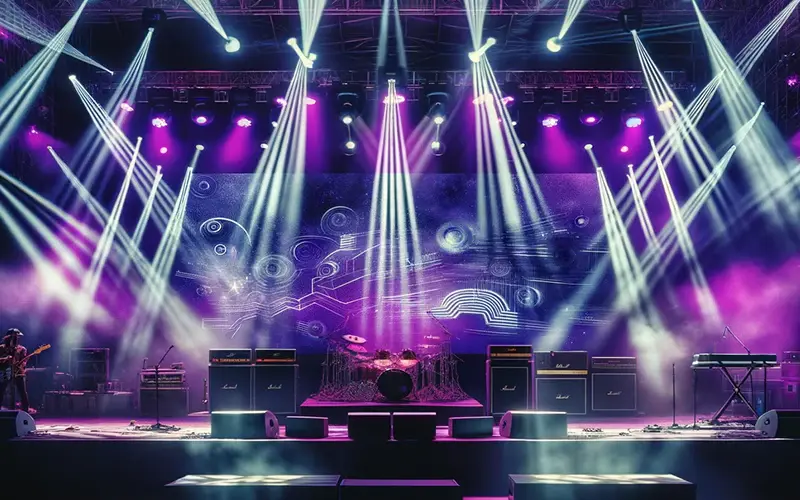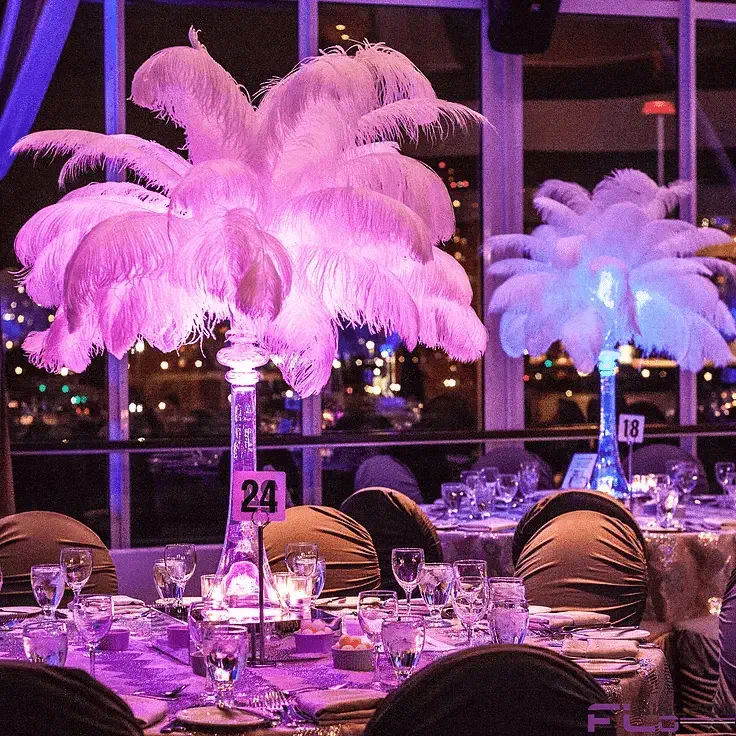
Stage and lighting are more than technical aspects of a performance, they are the soul and lifeblood that bring a show to life. Having worked in live events and theater productions for years, we can personally attest to the magic that excellent stage lighting brings. It doesn’t just illuminate; it narrates, establishes mood, and transports the audience into the world you’ve created.
What Is Stage and Lighting?
Stage and lighting refer to using light to illuminate a stage and performers during live performances or productions. When done well, stage and lighting design create the right mood, direct the audience’s attention, and add dramatic elements to support storytelling. Stage and lighting rental companies can provide quality equipment and expertise for any event.
Types of Stage Lights You Should Know
Understanding the various stage lights and their uses is fundamental to effective scene design and stage lighting.
Spotlights
These focused beams are employed to highlight specific performers or areas. I remember using a spotlight in a play to focus on a single actor, creating an intimate connection between the performer and the audience.
Wash Lights
Produce broad, even lighting across the stage. They’re perfect for setting an overall mood for a scene.
Floodlights
These are broad lights that illuminate vast spaces. They’re excellent when you want to light up large sets or backgrounds.
LED Lights
Energy-efficient and extremely flexible, LED lights are excellent for dynamic color changes. I enjoy using LED lights in concerts where changing colors provides energy.
Moving Head Lights
Programmable lights that can move and change color. They’re fantastic at producing dynamic effects during performances.
Black and White Stage Lighting
Creates dramatic contrasts and classic appearances. I’ve used black and white lighting to perform a vintage look.
Why Stage and Lighting Design Matters

Good stage and lighting design can make or break a show. I’ve watched low-budget shows become unforgettable on the strength of clever lighting alone. It is an art that combines technical expertise to ensure each moment on stage connects with the audience. Professional stage and lighting companies provide scene design and stage lighting experience to enhance performances.
Key Components of Stage and Lighting Design
Visibility
Ensures actors and set elements are visible in the right way. There’s nothing worse than watching an important moment get lost in the shadows.
Mood Creation
Uses color, lighting, and shadow to create mood. I once acted in a drama where we used cool blue colors to create a feeling of sadness, and it was incredibly powerful.
Focus and Direction
Brings the audience’s attention to important moments or figures. Lighting can be used as a visual cue, reminding the audience where they should focus.
Visual Effects
Provides dramatic elements such as strobe lights, changing colors, or projections. These effects can enhance performances and make them more engaging—I still remember how thrilling it was when we used strobe lights for an action scene.
Stage Lighting and Effects
Incorporates special effects to better the performance.
The Best Tools and Equipment for Stage and Lighting
For excellent stage and lighting, you need the right tools and equipment. Some of the lighting necessities and stage equipment are:
Lighting Fixtures
PAR cans, spotlights, and LED lights.
Control Systems
Lighting consoles and DMX controllers. Learning how to program these opens up a whole world of possibilities, I used to spend hours perfecting lighting cues for a show.
Accessories
Gobos, gels, and dimmers to control lighting effects.
Rigs and Trusses
Support frames to attach lighting fixtures.
Stage Lighting Clamps and Mounts
Secure lighting equipment in position.
If you prefer to create your setups, stage and lighting design software can be an enormous aid in planning and visualizing. It’s saved me hours of setup time.
How to Optimize Stage and Lighting for the Best Results
Optimizing stage and lighting requires technical modifications, creative artistry, and effective planning. Here’s how you can maximize your lighting design:
Familiarize Yourself with the Venue Layout
- Review stage dimensions, seating, and sightlines.
- Establish lighting requirements according to the type and scale of the event.
- I like to physically tour the venue in advance; observing the space helps me envision the lighting design.
Plan Lighting Zones
Center Stage
Utilize spotlights to illuminate primary areas of action.
Wings and Corners
Employ side or wash lights for even illumination.
Backdrop
Include backlights or projectors for depth.
Sketching out a lighting plot has been a great help in my productions.
Layer Your Lighting
Mix and match types of lights:
Front Lighting
Makes things visible.
Backlighting
Creates separation and silhouettes.
Side Lighting
Adds texture.
Top Lighting
Gives a natural appearance.
Layering lights provides depth on the stage, like painting with light.
Utilize Technology
DMX Systems
Program intricate light sequences.
LED Fixtures
Energy-efficient LEDs provide rich colors.
Intelligent Moving Lights
Create movement with programmable effects.
Embracing new lighting technology keeps your design dynamic and interesting.
Optimize Color and Intensity
- Change the color temperature to suit the mood.
- Utilize gels and filters for precise color effects.
- Balance contrast to prevent overly bright or dark spots.
Playing with colors is one of my favorite aspects of the process.
Incorporate Special Effects
- Include gobos for patterned textures.
- Utilize strobe lights during high-energy segments.
- Use haze machines to enhance light beams.
Special effects can elevate a performance—but use them wisely.
Synchronize with Sound and Performance
- Match lighting shifts with music and sound effects.
- Pre-program scenes to ensure smooth execution.
- Collaboration with the director and sound team is crucial—I’ve found that open communication makes for the best shows.
Test and Rehearse
- Perform technical rehearsals to refine settings.
- Utilize feedback to fine-tune for a polished outcome.
- There’s no substitute for rehearsal—seeing everything come together is always gratifying.
Frequently Asked Questions About Stage and Lighting

What is the most common stage lighting setup?
A standard configuration consists of front lighting, backlighting, and wash lights for overall balanced lighting.
Are LED lights suitable for stage lighting?
Yes, LED lights are energy-efficient, versatile, and great for producing dynamic effects.
How do I control stage lights?
Program and control your stage lights using DMX controllers or a lighting console.
What stage and lighting design software is available?
Several stage and lighting design software packages assist you in planning and visualizing light arrangements.
Bringing Your Performance to Life with Stage and Lighting
Stage and lighting are powerful mediums that transform performances, enhance storytelling, and captivate audiences. By mastering the basics and optimizing your setup with advanced strategies and the proper AV equipment, you can create a remarkable experience for your audience. Whether you’re utilizing stage and lighting rental services or investing in stage and studio lighting, the ideal AV company and approach will ensure your event shines.
I’ve discovered that the magic of a performance often lies in the details. When the lighting harmonizes with the music and performers, it creates moments that are remembered long after the curtains come down.

Comments are closed.